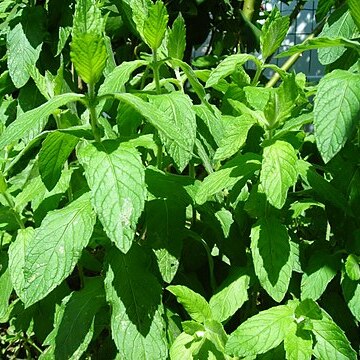Cal 10–13-nerved, regular or weakly 2-lipped, the broadly triangular to subulate teeth equal or unequal; cor with short tube and nearly regularly 4-lobed limb, the upper lobe formed by fusion of 2, tending to be broader than the others and often apically emarginate, rarely and casually the cor equally 5-lobed; stamens 4, straight, somewhat divergent, exsert, about alike, the pollen-sacs parallel; rhizomatous perennial herbs with toothed, wholly cauline lvs and small, blue to lavender or white fls in the axils of lvs or in terminal “spikes” or heads. Many spp. produce small-fld pistillate plants as well as normal perfect-fld ones. Ca 25 spp., mainly of Eurasia and Australia, 1 circumboreal. The European spp., long in cultivation, have given rise through hybridization, polyploidy, and other kinds of chromosomal aberration to numerous ± stabilized additional populations that have become established in the wild as well as being retained in cult.
Usually perennial, rarely annual, herbs with creeping rhizomes or stolons. Lvs simple, aromatic, usually toothed. Verticels usually dense, many-flowered, axillary or in terminal spikes or heads, or as few as 2 fls per verticel, or rarely fls solitary. Fls ☿ or ♀. Bracts leaflike or reduced. Calyx tubular or campanulate, 10-15-nerved, not gibbous at base, generally hairy inside; teeth (4)-5, equal or unequal. Corolla tube < calyx; limb 4-lobed, subequal and scarcely 2-lipped; upper lobe wider and usually emarginate. Stamens almost equal, divergent or lying together beneath upper corolla lip, generally exserted. Style gynobasic, its branches subequal. Nutlets ellipsoid to suborbicular or ovoid, smooth, reticulate or tuberculate.
Perennial herbs with creeping rootstocks, often strongly scented. Leaves often gland-dotted. Flowers small, in axillary verticillasters (in Mal.) or forming terminal spicate to paniculate inflorescences. Bracts often small. Calyx tubular or campanu-late, 10-nerved, 5-toothed, teeth subequal. Corolla funnel-shaped, short, 4-lobed, uppermost lobe broader than the other 3, emarginate, thus faintly 2-lipped. Stamens 4, slightly didynamous; anthers 2-celled, cells parallel; filaments almost free, erect. Disk entire, uniform. Style shortly subequally 2-branched. Nutlets ovoid, smooth or reticulate.
Infl. of whorled fls, us. in bracted spikes. Calyx 10-15-nerved, teeth nearly equal; corolla-tube short, lobes 4, nearly equal. Stamens 4, ± equal, mostly exserted. Nutlets ovoid, smooth. Perennial rhizomatous or stoloniferous herbs, with us. 4-angled stems and branches and fragrant opp. or whorled simple lvs. Some 30 spp., mostly of temperate regions, the N.Z. sp. endemic.

